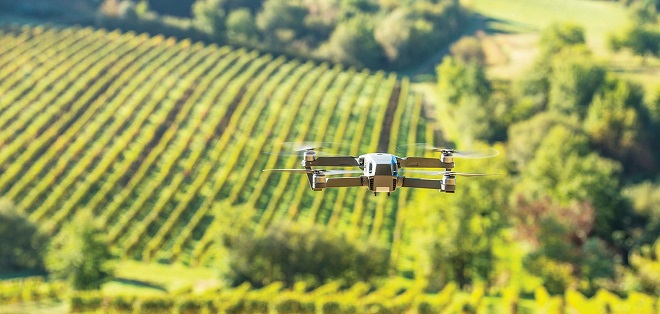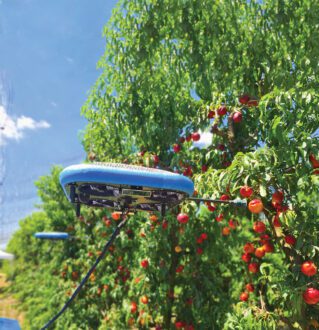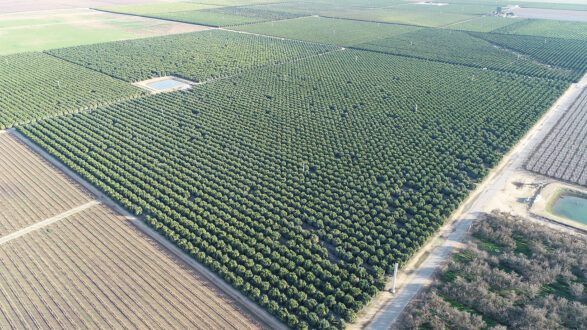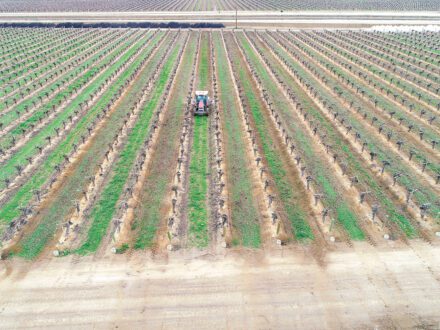

Aug 22, 2023Drone assignment: A costly investment, consider pros and cons
A recent addition in growers’ toolboxes, unmanned aerial systems (UAS) flying over orchards and vineyards can supply images to help orchardists and horticulturists more precisely and efficiently identify areas of concern.
Drones can increase efficiencies of inputs, targeting irrigation when plants need water and spraying for insects and weed control when most needed.


Drones help East Coast growers who, because of their farm size, typically don’t enjoy access to aerial applicator services, which prefer to service the larger row crop fields in the Midwest, said Kenny Strong, owner of Accurate Ag Spraying LLC. The Smithsburg, Maryland, drone seller’s customers range from growers who plant 14 acres to those overseeing 4,000 acres.
“Drones are a tool that basically any size grower can use,” he said. “The drones have come a long way from the days of being a 2-acre machine. Now, we’re up to 10-and-a-half gallons, and the next model that’s going to be coming out will be 13 gallons, so the size of the drone just continues to increase. The efficiencies went from a couple of acres an hour to up to 30 acres an hour. It’s really spiraled out of control in a great way.”
Drone harvesting systems can revolutionize peach and nectarine harvesting. The tech requires growers to plant slightly differently than usual.


“I don’t think there’s going to be any technology anytime soon that will come in and just take over your whole entire farm with AI and do it as your orchards and vineyards exist as they do today,” said Drew Ketelsen, vice president and farm manager of HMC Farms in Kingsburg, California. “I always tell people there are many ways to go about doing the same thing with technology, you have to adapt it to your operation and you have to adapt your operation to the technology.”
In the back seat of his truck, Martin Hein, co-owner of Hein Ranch Co., a Visalia, California, grower and farm properties manager of almonds, walnuts, pistachios and table, wine and cannery grapes, now packs a drone along with his shotgun and shovel.
“I can stop and can be airborne, taking images within two to three minutes,” he said.
SD cards can now record a day of flight and are capable of identifying image GPS coordinates, and drone technology has come a long way, Hein explained.
“Pull the drone out, set it on the ground, hit the button, and it flies,” Hein said. “And it flies the course and comes back to you. Then, you take out the battery, drive to the next ranch, and repeat.”
Grower investment While drones can be less expensive than in the past, owning and operating can represent a significant grower investment. Growers advise weighing the economies of scale and recouping their capital investments by passing that cost into the first year of operation.
Paying a worker to fly a drone on a farm with a couple thousand acres can run $10 to $15 an acre for season-long images that chart a crop’s progress through the entire season. But that compares to contracting with a supplier to provide seven aerial images and brief narratives that can cost up to $70 an acre per year, Hein said.


vineyards like this table grape vineyard in Kern county, California.
Photo courtesy of ColbyAgTech.
“One of the greatest advantages of using drones is their scalability, making aerial imagery applicable to both large and small farms,” said Adityah Singh, assistant professor of agricultural and biological engineering at the University of Florida. “The investment in drones or drone services can be tailored to the specific needs and scale of the application, providing flexibility and cost-effectiveness in various contexts.”
While entry level drones cost $400-$1,500, units regularly used on the farm can begin in the $2,500 range, Hein said. Longer flight times with larger platforms covering more acres can hike a year’s lease to $8,000. Spray platforms with higher capacity payloads can cost $30,000-$40,000 a year.
Hein compares drone ownership to golf. Beyond the bag and clubs, other extras, including shoes, clothing and hats, are needed. Growers soon begin buying extra batteries, carrying cases, different cameras and new software.
Despite a high initial investment, owning can be cost-effective in the long run, particularly if a grower requires frequent or ongoing aerial data collection, said Chad Colby, agricultural technologist consultant and owner of ColbyAgTech.com. Contracting the service, however, transfers the burden of maintenance, repairs and compliance to the service provider, reducing grower responsibility and allows them to focus on core operations, he said.
Providers may charge fees for services beyond standard offerings, including customized analysis and flight plans, specific images, data processing and capture settings. Expect to be charged for flight set up and take down and for additional equipment or sensors and add-on services.
Additionally, some providers may require insurance coverage and liabilities for their operations, while others may require that growers add the drone company as an additional insured party.
Growers should clarify insurance-related responsibilities and other costs up front, he said. Growers can avoid the inevitable lag in tech through leasing. The question of owning vs. leasing can come down to the high capital outlay required for rapidly changing technology.
There are times when drones may not make sense, said Michael Reinke, Michigan State University Extension viticulture specialist and integrated pest management educator for fruits and vegetables.
“The jury is still out whether drones will provide the coverage and efficacy in large fruit or nut cropping systems that ground-based sprayers currently do,” he said. “There are legal hurdles with airspace restrictions on farms near airports or other sensitive sites. So, the best route is a farm-by-farm decision.”
The biggest hurdle to drone use is the legal one.
“If you want to use a drone for scouting, identifying issues, or site planning, I think it could be worth it to buy a drone and some mapping software and try it out,” Reinke said. “If you are interested in an application drone, I would seriously think about contracting out at least at first to see if it is a fit for your farm before you look into the costs and certification challenges.”














